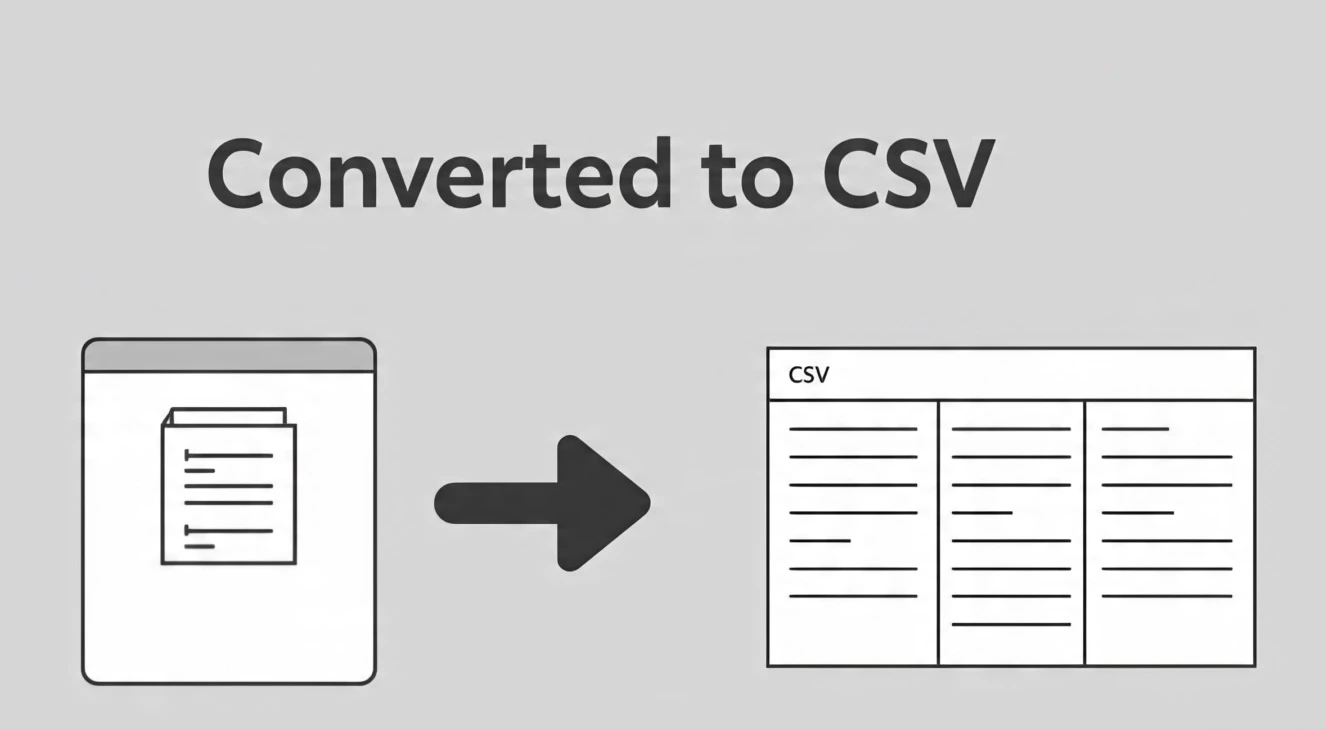
Excel Data Import and Export: Complete Guide for 2025
Excel Data Import and Export: Complete Guide for 2025
I'll let you in on a secret: most people think they know Excel, but they're barely scratching the surface when it comes to moving data in and out of spreadsheets. I've watched brilliant analysts waste hours manually copying and pasting data that could be imported in seconds. Even worse, I've seen companies make million-dollar decisions based on outdated spreadsheets because no one knew how to set up automatic data refreshes.
If you're tired of being Excel's data entry servant instead of its master, this guide will change everything. I'm going to show you the advanced import and export techniques that separate Excel power users from everyone else—methods that will save you hours every week and make your data workflows bulletproof.
Why Most People Get Excel Data Import Wrong
Here's what I see happening in offices everywhere: someone gets a CSV file, double-clicks it, Excel opens, and they think they're done. Six months later, they discover that Excel "helpfully" converted their product codes into dates and truncated their long ID numbers. Sound familiar?
The problem isn't Excel—it's that most people are using 1995 techniques in 2025. Excel has evolved into a sophisticated data platform, but everyone's still treating it like a glorified calculator. Let me show you what you're missing:
- Smart Data Types: Excel now recognizes stocks, geography, and even custom data types automatically
- Power Query Integration: Transform and clean data before it even hits your worksheet
- Dynamic Arrays: Import data that automatically expands and contracts as source data changes
- API Connections: Pull live data directly from web services and databases
- Automated Refresh: Set it once, and your data updates itself while you sleep
The Modern Excel Import Arsenal
Excel 2025 has more ways to import data than a Swiss Army knife has tools. Here's your complete toolkit:
Power Query: Your Data Transformation Superpower
If you learn only one thing from this guide, make it Power Query. This tool alone will transform how you handle data imports. Instead of fighting with messy data after it's in Excel, Power Query lets you clean, transform, and shape it before it even reaches your worksheet.
What Power Query Actually Does:
- Automatic Data Cleaning: Remove duplicates, fix formatting issues, and standardize data without touching the original source
- Column Transformations: Split names into first and last, extract dates from text, convert currencies
- Data Merging: Combine multiple files or data sources into one clean dataset
- Filter and Sort: Import only the data you need, pre-filtered and organized
- Refresh Capability: Update your analysis with fresh data in one click
Real-World Power Query Example:
Last month, I helped a client who was manually combining 50+ CSV files every week from different regional offices. Each file had slightly different column names and date formats. With Power Query, we created a single import process that:
- Automatically finds all CSV files in a folder
- Standardizes column names across all files
- Fixes date formatting inconsistencies
- Combines everything into one master dataset
- Updates automatically when new files are added
What used to take her 4 hours every Monday morning now takes 30 seconds.
File Format Mastery: Choosing the Right Import Method
Not all file formats are created equal, and Excel treats each one differently. Here's your format-by-format playbook:
CSV Files: The Trickster Format
CSV files look innocent, but they're full of traps. Double-clicking a CSV file is like playing Russian roulette with your data.
The Right Way to Import CSV:
- Use Data → From Text/CSV: Never double-click CSV files directly
- Preview Your Data: Check that dates, numbers, and IDs look correct
- Set Data Types: Explicitly tell Excel what each column contains
- Handle Encoding: Specify UTF-8 for international characters
- Custom Delimiters: Some CSVs use semicolons or tabs instead of commas
Database Connections: Direct from the Source
Why export from your database when you can connect directly?
Supported Database Types:
- SQL Server: Native integration with Windows authentication
- MySQL/PostgreSQL: Standard connection strings
- Oracle: Enterprise-grade connections
- Access: Still surprisingly common in small businesses
- Azure/Cloud Databases: Modern cloud-first approach
Web Data: The Internet as Your Data Source
Excel can pull data directly from websites, APIs, and web services. This is where things get really interesting.
What You Can Import from the Web:
- HTML Tables: Any table on any website
- JSON APIs: REST API responses converted to tabular data
- Stock Prices: Real-time financial data
- Currency Rates: Always up-to-date exchange rates
- Weather Data: For businesses affected by weather patterns
Advanced Import Techniques That Actually Matter
Dynamic File Imports: Handling Growing Datasets
Here's a scenario I see all the time: you set up a perfect import for January's data, but when February arrives with 20% more rows, your charts break and your formulas return errors.
The Dynamic Array Solution:
Excel's new dynamic arrays solve this perfectly. Instead of importing to a fixed range like A1:C100, use dynamic arrays that automatically expand:
- FILTER Function: Import only rows that meet your criteria
- SORT Function: Automatically sort imported data
- UNIQUE Function: Remove duplicates during import
- Spill Ranges: Formulas that grow with your data
Multi-Source Data Combining
Real business scenarios rarely involve just one data source. Here's how to combine multiple sources intelligently:
The VLOOKUP Killer: Power Query Merges
Instead of importing separate tables and using VLOOKUP to connect them, merge them during import:
- Import First Dataset: Your primary data source
- Add Related Data: Connect to secondary sources
- Define Relationships: Tell Power Query how tables connect
- Choose Merge Type: Inner join, left join, etc.
- Clean and Load: Get perfectly combined data
Export Strategies: Getting Your Data Where It Needs to Go
Import gets all the attention, but export is just as critical. The wrong export method can destroy hours of careful analysis.
Format-Specific Export Best Practices
CSV Export: Preserving Your Hard Work
CSV export strips all formatting, but that doesn't mean it has to strip your sanity:
- Prepare Your Data: Convert formulas to values first
- Format Numbers: Use TEXT function to preserve number formatting
- Handle Special Characters: Check for commas in text fields
- UTF-8 Encoding: Save as "CSV UTF-8" to preserve international characters
PDF Export: Making Data Presentation-Ready
Sometimes you need to export data for people who don't have Excel:
- Page Layout First: Set up page breaks and print areas
- Scale to Fit: Use "Fit to 1 page wide" for large datasets
- Headers and Footers: Add context and page numbers
- Export Quality: Choose "Minimum size" for email or "Print" for presentations
Automated Export Solutions
The real power comes when you automate exports so they happen without human intervention:
Power Automate Integration:
- Schedule Regular Exports: Daily, weekly, or monthly automatic exports
- Email Distribution: Automatically send reports to stakeholders
- Cloud Storage: Save exports directly to SharePoint, OneDrive, or Dropbox
- Format Conversion: Export the same data in multiple formats
Troubleshooting Common Import/Export Disasters
I've seen every possible way that Excel imports can go wrong. Here are the most common disasters and how to avoid them:
The "Leading Zeros Disappeared" Crisis
Problem: Product codes like "00123" become "123"
Solution: Set column data type to "Text" before importing, or use Power Query to pad with zeros
The "Dates Became Numbers" Nightmare
Problem: Excel converts "1/2/2025" to "45658"
Solution: Use Power Query to explicitly set date formats and regional settings
The "Everything Went to One Column" Mess
Problem: CSV data imports as one giant text string
Solution: Check delimiter settings and file encoding
The "Formulas Became Errors" Catastrophe
Problem: Exported formulas become #REF! errors in the destination
Solution: Convert formulas to values before exporting using Paste Special
Performance Optimization: Handling Large Datasets
Working with big data in Excel isn't just about having enough RAM—it's about using the right techniques:
Memory Management Strategies
- Import Only What You Need: Use Power Query filters to reduce data before it hits Excel
- Use Data Models: Store large datasets in Excel's data model instead of worksheets
- Compress and Clean: Remove unnecessary formatting and empty cells
- Split Large Files: Break massive imports into manageable chunks
Speed Optimization Techniques
- Disable Automatic Calculations: Switch to manual calculation during large imports
- Turn Off Screen Updating: Use VBA Application.ScreenUpdating = False for macro-driven imports
- Use Efficient Formulas: Replace VLOOKUP with INDEX/MATCH or XLOOKUP
- Minimize Volatile Functions: Avoid NOW(), TODAY(), and INDIRECT() in large datasets
Integration with Modern Business Tools
Excel doesn't exist in a vacuum anymore. Here's how to connect it with your broader business ecosystem:
Microsoft 365 Integration
- SharePoint Lists: Two-way sync between Excel and SharePoint
- Power BI Connection: Use Excel as a data prep tool for Power BI dashboards
- Teams Integration: Collaborate on shared Excel files within Microsoft Teams
- OneNote Embedding: Include live Excel charts in meeting notes
Third-Party Tool Connections
- Salesforce: Direct import of CRM data for analysis
- QuickBooks: Financial data integration for budgeting and forecasting
- Google Analytics: Website data for marketing analysis
- Survey Tools: Import responses from SurveyMonkey, Typeform, etc.
Security and Compliance Considerations
With great data power comes great responsibility. Here's how to keep your imports and exports secure:
Data Protection During Import
- Encrypted Connections: Always use HTTPS/SSL for web imports
- Authentication: Store database credentials securely using Windows Credential Manager
- Access Logging: Track who imported what data and when
- Data Masking: Import sanitized versions of sensitive data for analysis
Export Security Protocols
- Password Protection: Encrypt exported files containing sensitive data
- Watermarking: Add identifying marks to exported documents
- Distribution Controls: Use Information Rights Management (IRM) for exported files
- Retention Policies: Automatically delete exported files after specified periods
Future-Proofing Your Excel Data Workflows
The Excel landscape is evolving rapidly. Here's what's coming and how to prepare:
AI-Powered Data Insights
- Automatic Pattern Recognition: Excel's AI will suggest data transformations
- Smart Import Suggestions: AI will recommend optimal import settings
- Predictive Data Quality: Get warnings about potential data issues before they occur
- Natural Language Queries: Ask Excel questions about your imported data in plain English
Enhanced Cloud Integration
- Real-Time Collaboration: Multiple users editing the same imported dataset simultaneously
- Version History: Track changes to imported data over time
- Cross-Platform Sync: Seamless data access across desktop, web, and mobile Excel
- Enhanced Security: Advanced threat protection for cloud-based data connections
Your Next Steps to Excel Data Mastery
Here's the thing about Excel expertise—it's not about memorizing every feature. It's about developing a mindset that sees data as something fluid and manageable, not a static obstacle to overcome.
I want you to stop thinking of import and export as necessary evils and start seeing them as opportunities to add intelligence to your workflows. Every time you import data, ask yourself: "How can I make this smarter, cleaner, or more automated?"
Start with one technique from this guide. Maybe it's setting up your first Power Query transformation, or finally learning to import CSV files properly. Once you see the time savings and accuracy improvements, you'll naturally want to explore more advanced techniques.
Ready to transform your Excel data workflows? Pick the import or export challenge that's been frustrating you most, and apply one technique from this guide today. I guarantee that within a week, you'll wonder how you ever managed without these tools. Your future self—and your spreadsheets—will thank you for making the leap to modern Excel data management.


